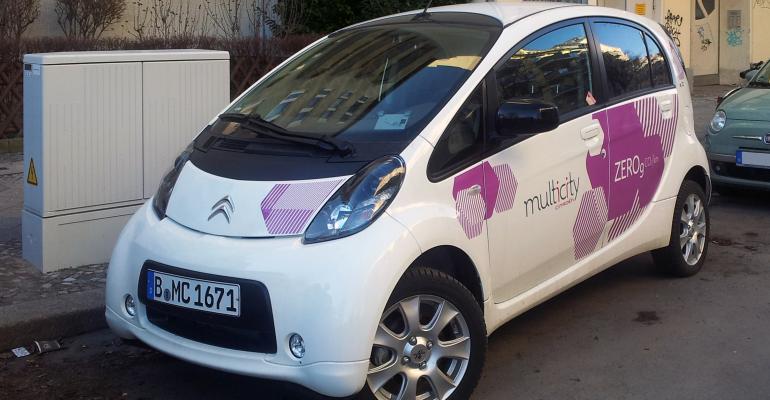TOKYO – European automakers sold a record 510,090 electrified passenger vehicles in 2016, including pure electrics and hybrids (mild, full and plug-in types), according to ACEA, the association of European automakers.
Electrified-vehicle sales of all types grew 21% from 235,604 units in 2015 to 303,506 units last year. PHEV sales rose 17% to 112,999 units, while sales of battery-electric cars gained 3% to 90,795.
Automakers sold 21,751 EVs in France, 11,410 in Germany, and 10,264 in the U.K.; 24,714 plug-in hybrids in the U.K., 18,612 in the Netherlands, and 13,751 in Germany; and 52,002 full and mild hybrids in the U.K., 50,961 in France, and 37,128 in Italy.
ACEA also reports sales of 176,730 alternative-fuel vehicles in 2016, down 20% from prior-year. Included in the total are natural-gas, liquid-petroleum-gas and E-85 ethanol vehicles. Italy held the dominant share, 82%, on sales of 145,461 units.
European automakers inched forward with powertrain plans largely built on smaller engines, more transmission steps, more hybrids and more EVs, according to the 2016-2017 edition of European Vehicle Market Statistics. Published by the Washington-based International Council on Clean Transportation, the report reveals:
- Diesel models declined as a percentage of total cars sold throughout the European Union in 2015 to 52%, from 53% the year before. Because demand for new cars (all powertrain types) grew 9.5% to 13.7 million during the year, diesel sales actually increased an estimated 491,000 units to 7.1 million.
- Of 1.7 million light trucks sold during the year, diesels accounted for 97% of the total.
- In the car segment, Volkswagen was the diesel leader on sales estimated at 911,620 units, 55% of the automaker’s total in Europe. VW was followed by BMW and Renault at 556,600 and 541,575 units, respectively 78% and 59% of sales.
- The share held by gasoline cars (excluding hybrids) declined slightly to 44%, from an estimated 44.5% in 2014. Unit sales, however, rose from 5.6 million to 6 million, again because of growth in overall demand.
- Cars with direct-injection engines accounted for 40% of the total, about 2.4 million units, up from 35% (2 million units) in 2014 and 3% (232,000) in 2005.
- Hybrids, excluding plug-ins, grew marginally from 1.4% to 1.5% in 2015. The segment registered growth from an estimated 175,200 units to 205,500. Toyota and its Lexus luxury brand held the largest combined share of hybrids at 27%, or 144,510 out 537,206 units sold.
- PHEV sales, of which 21% were in the Netherlands and 15% in Germany, grew 4% year-on-year in 2015, while EVs inched upward to 0.4% from 0.3%, and from an estimated 37,540 to 54,800 units. Renault and Nissan ranked 1-2 on EV sales estimated at 16,150 and 12,970, respectively. PHEVs accounted for 23% of Mitsubishi sales and 5% of Porsche deliveries.
- In vehicles powered by conventional engines, the average number of cylinders per engine remained constant at 3.9, unchanged from 2014, although down from 4.0 in 2010 and 4.1 in 2005. Peugeot and Citroen reported the smallest number of cylinders per car, 3.6, while luxury makers Audi, BMW and Mercedes reported the highest number at 4.3.
- Average engine displacement continued to decline while power increased to 1.61L and 125 hp in 2015, from 1.6L and 121 hp in 2014. In 2005 displacement and power averaged 1.73L and 110 hp and in 2010, 1.63L and 113 hp.
- In the light-truck segment, average power and displacement totaled 1.9L and 115 hp.
Against this backdrop, cars’ average carbon-dioxide emission levels fell to 120 g/km, from 123 g/km in 2014, while fuel economy increased to 48 mpg (4.9 L/100 km) from 47 mpg (5.0 L/100 km), based on the New European Driving Cycle. In 2005, CO2 and fuel-economy levels averaged 162 g/km and 36.2 mpg (6.5 L/100 km), and in 2010, 143 g/km and 40.6 mpg (5.8 L/100 km) in 2010.
The 2015 CO2 emission level of 120 g/km is significantly lower than the 2015 target of 130 g/km set by the European Union. In 2020, 95% of manufacturer fleets must reach 95 g/km, then 100% in 2021.
Emitting the smallest volumes of CO2, because of their smaller size and weight were cars built by Peugeot (104 g/km), Citroen (106 g/ km) and Renault (106 g/ km). Toyota, on the strength of its hybrids, came in fourth at 108 g/km.





